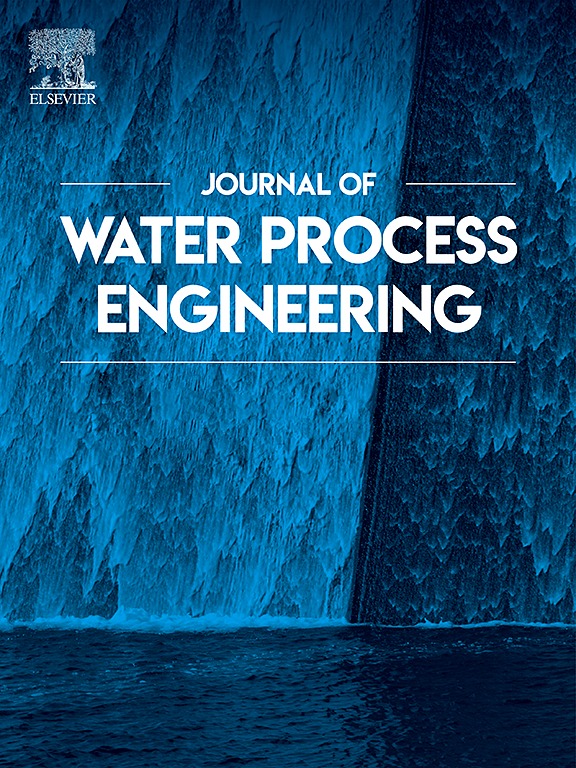The function of carbon quantum dots (CQDs) derived from peapod biomass in composite photocatalysts for the enhanced photodegradation of perfluoroalkyl carboxylic acids (PFCAs) under UVC and visible light irradiation
IF 6.3
2区 工程技术
Q1 ENGINEERING, CHEMICAL
引用次数: 0
Abstract
The remediation of perfluoroalkyl carboxylic acids (PFCAs) presents a significant challenge due to their environmental persistence and detrimental impact. In this study, carbon quantum dots (CQDs) were sustainably prepared using peapod biomass via the hydrothermal method and incorporated into a titanium dioxide (TiO2) composite photocatalyst. Chemical, morphological, and optical analysis confirmed the efficient synthesis of the CQD/TiO2 composite, which exhibited enhanced optical properties. Photocatalytic oxidation experiments demonstrated that the CQD/TiO2 composite achieved significantly higher degradation efficiencies for perfluorooctanoic acid (PFOA-C8) compared to pristine TiO2, with 26.3 % and 24.5 % improvements when irradiated under Ultraviolet-C (UVC) and visible light, respectively. Furthermore, the photocatalytic oxidation of short-chain PFCAs, specifically perfluorohexanoic acid (PFHxA-C6), perfluoropentanoic acid (PFPeA-C5), perfluorobutanoic acid (PFBA-C4), and perfluoropropanoic acid (PFPrA-C3), were evaluated under visible light irradiation. Degradation rates for PFHxA-C6 and PFPeA-C5 significantly enhanced from 14.6 % and 19.6 % to 41.3 % and 52.1 %, respectively, when using CQD-coupled TiO2 (CQD/TiO2) compared to pure TiO2. The first-order rate constants revealed accelerated PFCA degradation using PPCQD/TiO2 photocatalysts. Intermediate formation (C3–C6) and defluorination analyses revealed stepwise decomposition of PFCAs, with enhanced CF₂ detachment in the presence of the CQD/TiO2 composite. The role of scavengers in PFOA degradation under visible light was also examined. This research underscores the potential of CQD-enhanced TiO2 photocatalysts for effective PFCA remediation under sustainable conditions.

求助全文
约1分钟内获得全文
求助全文
来源期刊

Journal of water process engineering
Biochemistry, Genetics and Molecular Biology-Biotechnology
CiteScore
10.70
自引率
8.60%
发文量
846
审稿时长
24 days
期刊介绍:
The Journal of Water Process Engineering aims to publish refereed, high-quality research papers with significant novelty and impact in all areas of the engineering of water and wastewater processing . Papers on advanced and novel treatment processes and technologies are particularly welcome. The Journal considers papers in areas such as nanotechnology and biotechnology applications in water, novel oxidation and separation processes, membrane processes (except those for desalination) , catalytic processes for the removal of water contaminants, sustainable processes, water reuse and recycling, water use and wastewater minimization, integrated/hybrid technology, process modeling of water treatment and novel treatment processes. Submissions on the subject of adsorbents, including standard measurements of adsorption kinetics and equilibrium will only be considered if there is a genuine case for novelty and contribution, for example highly novel, sustainable adsorbents and their use: papers on activated carbon-type materials derived from natural matter, or surfactant-modified clays and related minerals, would not fulfil this criterion. The Journal particularly welcomes contributions involving environmentally, economically and socially sustainable technology for water treatment, including those which are energy-efficient, with minimal or no chemical consumption, and capable of water recycling and reuse that minimizes the direct disposal of wastewater to the aquatic environment. Papers that describe novel ideas for solving issues related to water quality and availability are also welcome, as are those that show the transfer of techniques from other disciplines. The Journal will consider papers dealing with processes for various water matrices including drinking water (except desalination), domestic, urban and industrial wastewaters, in addition to their residues. It is expected that the journal will be of particular relevance to chemical and process engineers working in the field. The Journal welcomes Full Text papers, Short Communications, State-of-the-Art Reviews and Letters to Editors and Case Studies
 求助内容:
求助内容: 应助结果提醒方式:
应助结果提醒方式:


